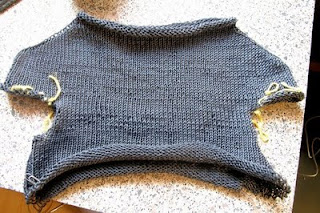Niikaua, kui uus asi kuivab (sellest räägin lähiajal rohkem), teen lubatud tehnilise postituse. Nimelt lubasin kunagi seletada, milles on contiguous-meetodi ja minu meetodi erinevused. Olgu kohe öeldud, et ma ei kirjuta siin ülevalt alla kudumise kõigist meetoditest, vaid mõnest, mille kohta on mult küsitud. Huvilised võivad vaadata Ravelrys
seda rühma, et näha erinevaid contiguous-meetodiga kootud asju.
So far a new project is drying (I will tell about it more in the nearest future), I am doing the promised technical post. Namely, once I promised to explain the difference between the contiguous method and my modification. If you are interested, you can check up this group on Ravelry to see various projects in the contiguous method.
Niisiis, esimene pilt on contiguous-meetodi skeem. Lihtsuse mõttes arutame sviitrit, mitte eest lahtikäivat kampsunit. Loome kaeluse silmused, märgime ära alguse/lõpu ja keskpunkti. Äramärgitud silmused on kasvatamisjooned või -teljed, kui soovite. Hakkame kasvatama igas reas (siin on vahe võrreldes klassikalise raglaaniga) enne ja pärast telge. Nõnda tekivad õlad, mida sümboliseerivad punased jooned. Kui õlg on valmis, siis muudame kasvatuste süsteemi. Paneme uued markerid 3-4 silmust enne kasvatusjoont ja ka järel. Need on uued orientiirid, mis tähistavad varruka ülemist osa. Nüüd koome markerini, libistame selle paremale vardale, kasvatame, koome järgmise marerini, kasvatame jms. Tekivad uued kasvatuse jooned (sinine joon). Varruka kasvatused on siin põhimõtteliselt sellised, nagu kirjeldab Barbara Walker (õigemini, üks tema meetoditest).
So the first picture is a schematic presentation of the contiguous method. For the sake of simplicity let us consider a sweater and not a cardigan that has an opening. We cast on stitches for the neck, join them to work in round, mark the beginning/end of the row and the middle. The marked stitches are the lines along which we will do increases. We are going to increase in every row (this is different from a classical raglan) before and after the line. In this way we will obtain the shoulders that are marked with red lines in the picture. When the shoulders are done, we change the system of increases. We shall place new markers 3-4 stitches before and 3-4 stitches after the increase line and by doing this we mark the cap of the sleeve. Now we knit to the marker, slip it, make an increase, work to the next marker and make an increase. We have new lines of increase, marked with blue. The sleeves in this method are knitted according to one of the principles described by Barbara Walker.

Teine pilt on siinsetele lugejatele tuttav. Contiguous-meetodi austajatelt ei saanud ma selget vastust, kas minu modifikatsioon langeb ikka sellesse liiki või mitte. Alustame ühtemoodi. Kuid varrukad koon teise põhimõtte järgi. Teen kasvatused kuni õlg on täiesti kaetud või isegi pisut rohkem. Siis koon mõnda aega üldse ilma kasvatusteta. Keegi küsis, mida teha, kui käed on täidlased. Pakkun, et võib mõnes reas kasvatada ühtlaselt mõned silmused. Koon, kuni on aeg eraldada varrukad. Pildil on varruka silmused võetud abilõngale. Siis loon kindlasti mõned silmused käeaugu alumise osa jaoks, ühendan uuesti ja koon ringselt alla.
The second picture is familiar to my readers. I could not get a clear answer from fans of the contiguous method whether my modification still can be classified under this method or not. We start in the same way. But I make sleeves according to another principle. I make increases until the shoulder is completely covered or even a little more than that. Then I knit without increases for a while. Someone has asked what should be done if the upper arms are massive. I suggest you can make some evenly distributed increases in one or two rows. I knit until it is time to separate the sleeves. In the picture the stitches of the sleeves are on a waste yarn. Then I certainly cast on some stitches for underarms, join again and work in round downward.

